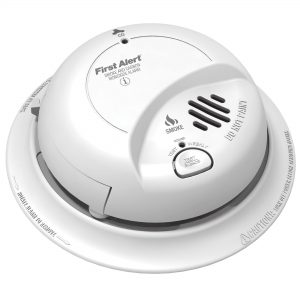
Carbon monoxide detectors are very valuable for ensuring the safety of your home and family. Odorless and colorless, it is very difficult to tell when carbon monoxide is present. However, this deadly gas can find its way through your home through a number of seemingly harmless sources. When it does, it can cause unconsciousness within minutes, not to mention permanent damage. Find out more about carbon monoxide and the potential harm is can cause as well as what you can do to prevent poisoning with a carbon monoxide detector.
What is Carbon Monoxide?
Carbon monoxide is an odorless and colorless gas and the only way to detect it is with a carbon monoxide detector. This gas is released when fuels, like wood, gasoline, coal, propane, natural gas, gasoline and heating oil, do not burn completely. This is an occurrence that can take place in common appliances like clothes dryers, water heaters, ovens, ranges, as well as a fire burning fireplace or a car left running in an enclosed space.
Once carbon monoxide passes through the lungs, it enters the red blood cells and binds to hemoglobin, where oxygen is typically found. Once this happens, carboxyhemoglobin is formed. This interferes with the transportation and gas exchange of oxygen in the red blood cells. Because the body is starved of oxygen, flu like symptoms occur, accompanied by shortness of breath, nausea and mild headaches. As exposure to carbon monoxide continues, permanent brain and lung tissue damage and suffocation may occur.
How Do Carbon Monoxide Detectors Work?

One way to prevent exposure to carbon monoxide is by using a detector. It can be purchased on their own, or be included in a full security system. It works by sounding an alarm when carbon monoxide is detected. There are several different types of carbon monoxide detectors and each has its own way of responding to the presence of carbon monoxide.
Biomimetic Sensor: It contains a gel that changes color when it absorbs the carbon monoxide. The change in color triggers the alarm.
Metal Oxide Semiconductor: It contains the technology of silica chip circuitry. When this circuitry detects the carbon monoxide, the electrical resistance is lowered and the alarm is triggered.
Electrochemical Sensor: It contains electrodes that are immersed in a chemical solution. When these electrodes come into contact with carbon monoxide, the electrodes sense changes in electrical current, thus, triggering the alarm.
All detectors’ alarm is activated until the presence of carbon monoxide is no longer detected.
What Do I Do If My Carbon Monoxide Detector Goes Off?
If your carbon monoxide detector alarms, it’s important not to panic. Your first course of action should be to get everyone out of your house. Open windows on the way out if possible.
Once you are safely outside, determine if anyone is showing symptoms of carbon monoxide poisoning and call the paramedics if necessary.
A monitored system will alert emergency services because of their capability to inform the provider’s team if there’s an increase in the level of carbon monoxide. They will be able to provide the appropriate medical care needed and determine the cause of the carbon monoxide in your home. A monitored system may also be the way to go due to the fact that carbon monoxide can cause unconsciousness within minutes. They will ensure that paramedics arrive to rescue anyone who is unable to get out of the house on their own.
Where to Place Your Carbon Monoxide Detectors?
Before investing in a carbon monoxide detector, it is important to make sure you are purchasing the correct type or configuration of the product. Your local law will have certain requirement mandating which ones you should buy. Be sure to check which ones are permitted before purchasing.
The National Fire Protection Agency (NFPA) also mandates that the carbon monoxide detectors be present in specific locations. There must be one on each floor of the house and outside the doors of sleeping areas. Local laws may have additional requirements so it is wise to look into that as well, before installation occurs. A monitoring company will also come in handy in this capacity as they will be able to do the installation for you, ensuring everything is up to code.
Another consideration you may want to make when purchasing a carbon monoxide detector is whether you want a battery operated model or a plug-in. Plug-ins are convenient because you can move them from room to room. However, in the case of a power outage, it’s a good idea to have some sort of battery backup to ensure they continue working.
Most homes will feature at least one battery operated unit which would be permanently installed when the smoke detectors or security systems are installed. These units can be linked to the rest of the detectors in your home and will be activated if one goes off in another part of your home.
Carbon monoxide is a very dangerous gas and is very difficult to detect so a detector is definitely a worthwhile investment for homeowners. If you are interested in getting carbon monoxide protection in your home, do some research to make sure you are buying the correct type of detector and that it is installed up to code. Do the very most you can in protecting your family by investing in a carbon monoxide detector.

